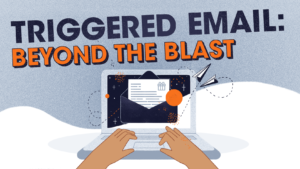
The scene: a late-night Amazon scrolling session where your cart is full of must-have items like an avocado slicer, a tofu press, and a vintage butter knife. But wait! You put down the phone and go to sleep, your wallet thankful for your willpower.
But then! The next morning you get the email you didn’t want to see…the abandoned shopping cart email. It stares you down with all the items in your cart, and even, unbelievably, more item recommendations you now know you need to have. Amazon got you with an expertly designed and delivered triggered email. How did this happen?
We’ll tell you.
- What are triggered emails?
- Transactional Emails
- Promotional Emails
- Triggered email examples
- Measuring triggered email success
- Conclusion
What is triggered email?
Email marketing is a versatile tool when you go beyond what some call “batch and blast.” By setting up triggered email sequences or single emails triggered by activity, you can hyper-personalize email for better engagement and a better sender reputation for ALL the email you send, which can build trust.
Unlike common email “blast” or email sent to an entire email list, a triggered email is closer to true one-to-one communication. The simplest way to describe a triggered email is “the right email at the right time,” and can be configured for multiple use cases to save you time. Triggered emails can be used to capitalize on a recipient action (like reminder emails, special offers, and cart abandonment emails), fulfill a request (password resets and confirmation emails), or celebrate an event (birthdays, anniversaries).
There are two general categories of triggered email with lots of nuance and detail in each one. Let’s take a look.
Transactional Emails
Transactional email is a foundational use case for triggered email, and it’s also got a big difference from marketing email: They’re time-sensitive. Sure, a marketing email could have a limited-time promotion, but transactional email often has a recipient waiting for its arrival.
Examples of transactional emails include order confirmations and receipts. A purchase should automatically trigger the deployment of a receipt email without significant lag time. This is where email science starts to creep into the discussion.
There are two major points to be made in a discussion about transactional email. If it’s important mail, which it likely is, it needs to be able to be delivered as quickly as possible. If you’re sending large amounts of marketing email messages from the same mail stream, your transactional email could get throttled or simply lost in the shuffle. You’ll likely want to send transactional email from a different stream to better ensure it’s delivered quickly and without interference from mailbox providers (MBPs), which they’re more likely to do on large-volume sends.
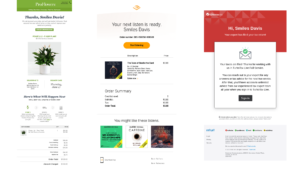
Second, the engagement on transactional email is usually much higher than traditional marketing email. Why? Transactional email is often the very definition of “wanted email.” Everyone wants to be sure their order reached the merchant. This positive engagement sends likewise positive signals to MBPs reinforcing their decision to not filter mail from this sender away from the inbox. This can positively skew the overall reputation of a sender, meaning if your triggered transactional emails are effective and timely, your overarching marketing email might benefit from better MBP treatment overall.
Operational email
Operational email is a triggered email example similar to transactional email without a lot of marketing value. Instead, it’s designed to create a satisfactory user experience. IT pros will want to configure operational triggered emails. These are similarly time-sensitive emails because they’re actually requested by the recipient. Whether a password reset or two-factor authentication request, these triggered emails need to be quick and reliable, basically in real-time, underscoring the need for a positive and consistent reputation. These also should be separated from the overall marketing email stream, along with transactions, to better ensure these triggered emails aren’t caught by spam filters or held up via throttling caused by other larger sends potentially happening at the same time.
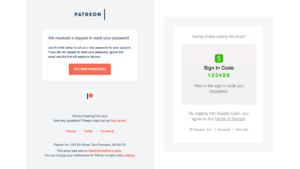
Promotional Emails
The next common triggered email use cases is promotional email. There are so many versatile ways to use promotional triggered email, but it tends to be overlooked because triggered transactional emails are just a little more straightforward. When you approach it strategically, promotional triggered mail can result in the highest open rates.
How is promotional triggered email different than transactional?
Promotional triggered email includes some of the most well-received communications. We go in-depth into the use cases and some examples a little later in this guide, but the TL;DR version is they are any email based on an action a user takes that isn’t explicitly sales related. Think welcome emails, onboarding, restock notifications, and so on.
These emails meet the goal of true personalization. They are emails based on you and your actions rather than a marketer’s best guess about what email is right at the moment.
How do you send promotional triggered email?
There are two primary ways to deploy this version of triggered mail.
- Incorporate into a marketing automation workflow
- Deploy in a similar manner to transactional email via API/SMTP email providers
The first instance is fairly straightforward in which you simply include promotional emails in whichever automated flow you’ve created to send emails to your recipients.
But in the case of the second, triggered promotional email performance is often neglected (usually unintentionally) because it’s assumed it will perform similarly to triggered transactional content.
This, friends, is a significant oversight because delivery issues can have a dramatic effect on revenue. This is a huge risk because major issues are often only detected after revenue tanks, and the small issues, like a poorly performing triggered email, can go undetected despite causing revenue declines.
Triggered email challenges
This is a great segue into some of the challenges all triggered email can face, whether transactional or promotional.
A common issue for both categories is reputation, be it from a shared IP or domain reputation. Much like any batched email, if your triggered email comes from a shared IP, you’re at risk of sharing it with less than savory senders (yuck). Plus, even though transactional email has a much higher engagement rate than other forms of email, if you get lots of unsubscribes and low engagement on other emails you send, those critical transactional emails could errantly get caught in the spam web simply because some of your other mail is getting stuck there, too.
Triggered email should also provide a very high first contact resolution rate, because they are designed be sent quickly to address a specific issue. If your email isn’t resolving the issue immediately, like if they need to send multiple requests for the email to actually arrive, you might need to look into your reputation.
Promotional email is subject to even more challenges. First, it often gets treated like its sibling, transactional email. While in some cases the similarities are harmless, in other cases, it can be a disaster for performance. Since promotional triggered mail can be deployed in a similarly technical manner as transactional, its performance is easy to overlook and many just assume it enjoys the same level of engagement as transactional mail.
Wrong. Very wrong.
All the email best practices that are super important to follow for great email engagement and success absolutely need to be applied to triggered promotional email. There needs to be a developed contact strategy, there needs to be adequate data hygiene, and overall, there must be a solid marketing strategy. This is not a simple set-and-forget, and if you treat it as such, forget about your ROI!
But here’s the challenge for marketers: Proactive guidance is not readily available. Your typical email provider probably doesn’t have the resources or even the knowledge to help you navigate a triggered email stream. Thus, you don’t have a great support system to ensure the success of this really important mail stream.
We’ll pick up our own horn here and toot it just a little bit. SocketLabs gets it. In fact, we have a Concierge service specifically designed to help you understand and optimize your triggered email marketing strategy. Triggered mail is a specialized discipline and we’re proud to be specialists.
Triggered Email Examples
There are right ways to use triggered email and there are wrong ways. Doing the wrong things can cause major reputation damage while using them appropriately can increase email engagement and improve the efficacy of your email program overall. But remember, consider user experience – when do they want to receive an email or when would an email feel creepy? Missteps like those can push a recipient to complain about the email and damage your sender reputation.
Here are some common types of email.
Personalized emails
Like the midnight Amazon shopping spree demonstrated, personalized marketing emails can be super effective in getting the recipient to take action. We all know you typically shouldn’t try to be everything to everyone, and neither should email. Personalizing email to the recipient is key in encouraging positive engagement, but personalization can be difficult, if not for triggered email.
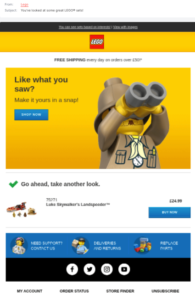
An abandoned shopping cart email is a perfect example of a personalized triggered email. A full cart sits for a given period of time, and if it isn’t actioned in some way, an email auto-sends to remind the shopper of what’s waiting to be purchased. Other examples include data-triggers, like birthdays or anniversaries. Surprising and delighting subscribers with the data they’ve provided can be super effective in demonstrating the brand’s appreciation without making the recipient feel like they need to do something to be rewarded.
Discounts related to previous purchases can also be a wise way to structure a re-engagement campaign and those triggers can be fairly straightforward. If any customer purchases Product A, in one- or two-weeks’ time they can receive an email about Product B, just by virtue of their first purchase.
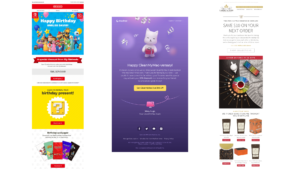
Demand Gen
You’ve got a campaign in mind with a journey mapped out. Once someone downloads an asset, they’re put into a group of potential clientele and become sales targets. If they’ve provided their email address for a marketing asset, they can be put into a drip campaign using triggered email.
Like our friend Sir Isaac Newton told us, every action has an equal and opposite reaction. Your prospect gives you information (for example, they clicked on a percent-off coupon for books) and that action triggers an email reaction giving them information (perhaps recommended new book releases). Setting up these complex systems of actions and responses can create a robust campaign for sales prospects to warm up people already in a funnel.
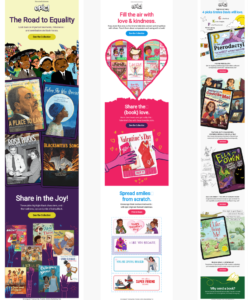
Without using triggered email, this kind of email use case would require batching people by action, such as a group who opened a specific email but did not click, a group who opened and did click, and a group who received but didn’t open the email. Then three emails need to be created and scheduled to be sent en masse.
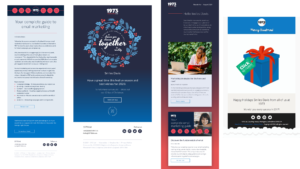
With triggered email, if a user clicks on a link within an email, they’re automatically qualified for that group’s next email, which can be scheduled for any amount of time after the action. For example, if I click to download an ebook from a drip-campaign email, in one week I might receive another email with an asset related to the ebook I requested. That email can be sent without any additional work from the email marketer. So, you’re providing a prospect with consistent engagement without making additional work for you every week. Win-win, for both B2C and B2B use cases!
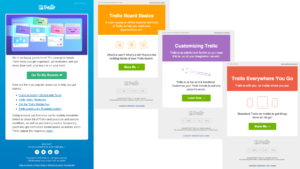
Welcome emails
You want new subscribers to feel welcome. If you don’t, they might snag the discount you offered for their email address and promptly unsubscribe the next time they receive a discount-less email from you. To help avoid immediate disengagement, you can consider using an onboarding email campaign automatically sent via trigger.
Not only will the first email be triggered by the sign-up request, but you can schedule additional automated emails to continually provide incentives based on their reactions to each email. Like demand gen, this is a great opportunity for e-commerce marketers to warm people up to your email without spending lots of time using intricate segmentation to match subscribers to batch emails.
Measuring triggered email campaign success
According to our data, any kind of triggered message enjoys much greater engagement than a larger “blast” email, be it marketing or transactional in nature. In fact, triggered, highly targeted marketing messages get opened nearly three times as frequently as a mass email and are thus much less likely to get filtered into spam. The engagement signals get even higher when talking about emails sent in direct request of the recipient, like a password reset.
But even operational and transactional email has lots of great learnings within its engagement data. Since SocketLabs tracks every open and click, not just the first occurrence of each, we’ve seen transactional email generating more than 170% open rates and almost 80% click-through rates. Yes, these are wild metrics.
Promotional email campaign stats
Promotional triggered email enjoys similar success. Let’s look at a common scenario: 74% of people who subscribe to an email list expect to receive a welcome email. Yes, they are actively expecting you to email them. BIG opportunity.
Yet, only 57% of brands even send one. So almost three-quarters of people expect it, but only just over half deliver (get it?). That’s a huge miss. Huge to the tune of 320% more revenue generated via welcome emails than by email blasts and other promotional emails! This is probably because they enjoy a 14.4% click rate over other mail’s average 2.7% rate.
If that isn’t compelling enough, new customers who receive a welcome email are 33% more engaged than those who didn’t. How engaged? Well, the conversion rate on welcome emails is 0.94% compared to 0.10% for typical email. Come on, now. This is a huge opportunity to start the customer lifecycle on the right note, and if you follow up with intentional and personalized email marketing campaigns, you’re more likely to see higher customer retention.
But interestingly, engagement tracking on triggered email is not usually done by default within email service providers (ESPs). There are benefits to keeping engagement tracking off, predominantly for security or performance reasons. But, there are also positives to turning it on.
For example, if people are consistently unsubscribing to a demand gen drip at email number five, consider ending the journey at the fourth email. Allowing a drip to continue to trigger emails when the recipient stopped engaging is a surefire way to chip at a good sender reputation.
Another great case for turning on tracking for triggered emails is the ability to analyze and adjust your triggered marketing mail. If people are marking abandoned cart emails as spam, consider changing messaging to be clearer in your intent. Does your subject line reference an order not yet placed, or is the subject line so vague as to not indicate its intent?
Conclusion
Here’s the bottom line: Triggered email can make your life easier if you do it correctly. You can have multiple email streams operating at the same time to make everyone feel engaged. Beyond a large distribution with a general sale available to everyone, you can also have an abandoned cart email sent around the same time without any additional work to do so. Then, that same person could request a password reset and place an order all within a half hour. All those emails can and should be triggered to get them to the recipient quickly and reliably, cementing a great customer experience.
To do this, you need to personalize triggered emails, set up intelligent frameworks to send the right email at the right time, and keep a close eye on engagement signals to understand what’s working and what isn’t. Without the right infrastructure, you risk over-emailing, dinging your reputation, and making those mission-critical emails like password resets harder to deliver.








